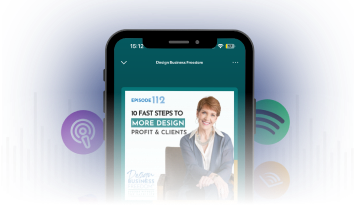The Welcome Kit That Wins Clients
Creating a memorable first impression is crucial in the interior design business. One of the best ways to do that is through a well-crafted interior design welcome kit. In today’s post, we’ll walk through how to assemble a welcome kit that not only impresses potential clients but also sets the stage for a successful working relationship.
Why an Interior Design Welcome Kit is Essential
An interior design welcome kit is more than just a collection of materials. It’s a powerful marketing tool that helps you stand out from the competition. It communicates your professionalism, attention to detail, and commitment to client care. Whether delivered physically or digitally, your welcome kit should reflect your brand’s personality and the high level of service clients can expect from you.
When and How to Deliver Your Interior Design Welcome Kit
Timing is everything when it comes to delivering your welcome kit. Ideally, you should present this during your first consultation. This might be called a home review, comfort and style assessment, or an aesthetic and functional evaluation. By delivering a printed welcome kit in a beautifully branded folder at this point, you leave a lasting impression. For a younger or more tech-savvy clientele, a digital version might be more appropriate. But remember, design is a tactile field, and a physical kit can make a stronger impact.
What to Include in Your Interior Design Welcome Kit

The contents of your interior design welcome kit should be consistent whether it’s digital or physical. Here’s what you should include:
Meet the Firm: Provide a friendly introduction to you and your team, including contact information for key members. If you’re a solopreneur, this section will focus on you, but consider highlighting any part-time assistants or virtual support as well.
Your Process: Outline the steps you’ll take in the design process, using clear, client-friendly language. Avoid industry jargon like “schematic” or “rendering” and instead opt for terms that anyone can understand. For example, refer to a “photorealistic illustration” rather than a “rendering.”
Testimonials: Weave testimonials throughout your interior design welcome kit to provide social proof of your expertise. These can be strategically placed in sections like Meet the Firm and Your Process, or included as part of case studies.
Case Studies: Include two to three case studies that showcase your best work, tailored to the type of project the client is interested in. Each case study should feature a project brief, the challenges you solved, the solutions you provided, and a testimonial from the client.
Interior Investment Guidelines: Provide a document that helps clients understand the financial aspects of working with you. This should include a detailed breakdown of potential costs for specific rooms. It should also include information on design fees and procurement management.
The Power of Presentation
Whether you choose to deliver your interior design welcome kit digitally or physically, presentation matters. For physical kits, consider using a high-quality folder with key images from your portfolio and a few well-placed testimonials. The goal is to create something that’s not only informative but also visually appealing—a piece that clients will want to keep and refer back to.
Key Takeaways
A well-designed interior design welcome kit is a key tool in winning clients and setting the stage for a successful partnership. By including essential information, showcasing your best work, and delivering it in a professional manner, you demonstrate your commitment to excellence from the very first interaction. Whether digital or printed, your welcome kit should reflect the quality and care that define your design business.
If you’re ready to increase your interior design practice profits, work exclusively with ideal clients, and enjoy the time and resources for your extraordinary life, explore your coaching options. We’ve got your back in the business of interior design.





